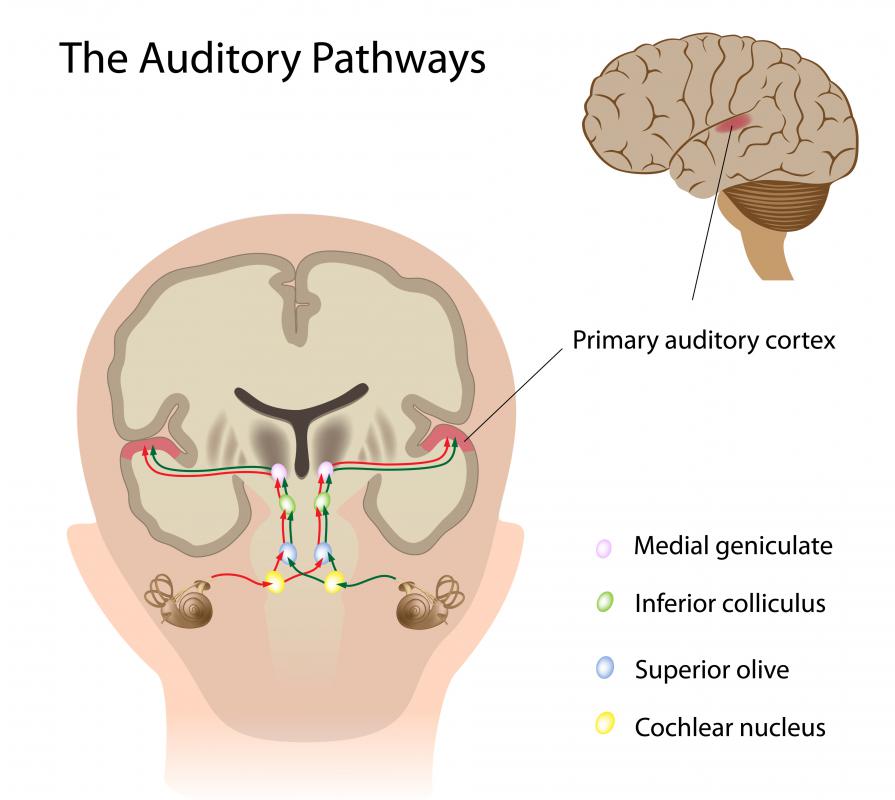At WiseGEEK, we're committed to delivering accurate, trustworthy information. Our expert-authored content is rigorously fact-checked and sourced from credible authorities. Discover how we uphold the highest standards in providing you with reliable knowledge.
What is the Inferior Colliculus?
There are four large contiguous structures in the midsection of the human brain that are primarily reserved for the visual and auditory senses. The top two lobes, called the superior colliculus, are connected to the two eyes. The bottom two, called the inferior colliculus, are responsible for processing the signals derived from the left and right ears. These two important human senses are made possible precisely by this simple, split anatomy of the brain.
The cochleas of the inner ear are the snail-shell-shaped terminal ends of the human auditory system. Its curled, tapered and fluid-filled chamber is lined with cilia — hair cells that vibrate in response to particular frequencies and trigger a nerve cell to pulse electrically. All of the nerve cells emanating from a cochlea bunch together into the acoustic nerve. Several other major nerves converge with the acoustic nerves to form a neural bundle called the lateral lemniscus, which heads toward the brain.

The lateral lemniscus’ point of entry is the mid-brain, just above and in front of the medulla, or brainstem, and below and behind the cerebrum lobes of the forebrain. In addition to the basic neuroanatomy of the human brain being left and right halves, the rear area of the mid-brain is divided into upper and lower halves. The resulting four, roughly round lobes are called the corpora quadrigemina. The larger top halves are the superior colliculi, and the slightly concave bottom pair are the inferior colliculi.

The inferior colliculus is organized in three parts. There is a compact central nucleus, or ganglion cluster of multi-polar neurons. It is encased by outer dorsal and lateral cortexes, which are a dense web of bimodal nerve cells derived from the lateral lemniscus.
The lateral lemniscus enters the brain at the base of the inferior colliculus. Some of the individual nerves of the lateral lemniscus pass through and on to the thalamus and cortex of the temporal lobe, where signals from multiple sensory and cognitive sources can integrate. Some nerves terminate within the central nucleus. Most of the nerves cross over and terminate at the inferior colliculus of the opposite side.

Nearly all human auditory signal pathways route to the inferior colliculus. It also receives neural signals from the superior colliculus, somato-sensory nerves fibers from the brainstem and higher-function input from the auditory cortex of the forebrain. Although these connections are mostly bimodal, the majority of the output signals of both inferior colliculi projects to the brain’s medial geniculate body whose function is akin to a switchboard for further cognitive analyses. The job of the inferior colliculus is the most basic, such as pitch discrimination, ramping frequency recognition and the startle reflex.
Most signals sent by the right ear cross over to the left inferior colliculus of the human brain, and vice versa for the left ear. This binaural parallel processing of the mechanical energy of compressed air waves, otherwise known as sound, is essential to human perception. Not unlike radar triangulation, one colliculus compares a given signal with its counterpart in the opposite side colliculus for variable differences such as time lag and doppler shift to localize the source of the sound within three dimensional space. Human binocular vision, processed by the twin superior colliculi, is enabled by the same basic principle.
AS FEATURED ON:
AS FEATURED ON:













Discuss this Article
Post your comments